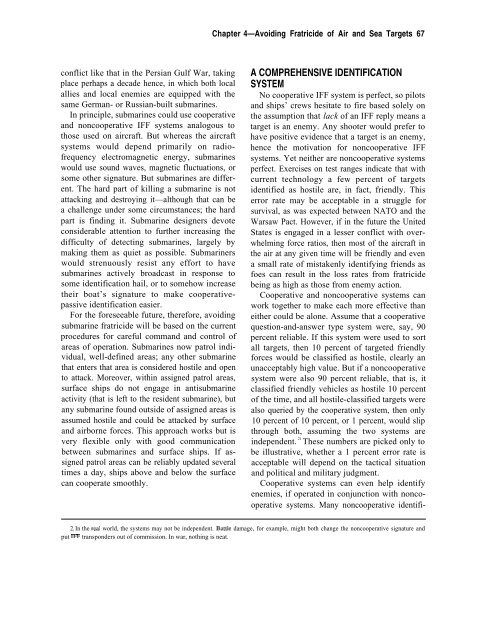Who Goes There: Friend or Foe? - Federation of American Scientists
Who Goes There: Friend or Foe? - Federation of American Scientists
Who Goes There: Friend or Foe? - Federation of American Scientists
Create successful ePaper yourself
Turn your PDF publications into a flip-book with our unique Google optimized e-Paper software.
conflict like that in the Persian Gulf War, taking<br />
place perhaps a decade hence, in which both local<br />
allies and local enemies are equipped with the<br />
same German- <strong>or</strong> Russian-built submarines.<br />
In principle, submarines could use cooperative<br />
and noncooperative IFF systems analogous to<br />
those used on aircraft. But whereas the aircraft<br />
systems would depend primarily on radi<strong>of</strong>requency<br />
electromagnetic energy, submarines<br />
would use sound waves, magnetic fluctuations, <strong>or</strong><br />
some other signature. But submarines are different.<br />
The hard part <strong>of</strong> killing a submarine is not<br />
attacking and destroying it—although that can be<br />
a challenge under some circumstances; the hard<br />
part is finding it. Submarine designers devote<br />
considerable attention to further increasing the<br />
difficulty <strong>of</strong> detecting submarines, largely by<br />
making them as quiet as possible. Submariners<br />
would strenuously resist any eff<strong>or</strong>t to have<br />
submarines actively broadcast in response to<br />
some identification hail, <strong>or</strong> to somehow increase<br />
their boat’s signature to make cooperativepassive<br />
identification easier.<br />
F<strong>or</strong> the f<strong>or</strong>eseeable future, theref<strong>or</strong>e, avoiding<br />
submarine fratricide will be based on the current<br />
procedures f<strong>or</strong> careful command and control <strong>of</strong><br />
areas <strong>of</strong> operation. Submarines now patrol individual,<br />
well-defined areas; any other submarine<br />
that enters that area is considered hostile and open<br />
to attack. M<strong>or</strong>eover, within assigned patrol areas,<br />
surface ships do not engage in antisubmarine<br />
activity (that is left to the resident submarine), but<br />
any submarine found outside <strong>of</strong> assigned areas is<br />
assumed hostile and could be attacked by surface<br />
and airb<strong>or</strong>ne f<strong>or</strong>ces. This approach w<strong>or</strong>ks but is<br />
very flexible only with good communication<br />
between submarines and surface ships. If assigned<br />
patrol areas can be reliably updated several<br />
times a day, ships above and below the surface<br />
can cooperate smoothly.<br />
Chapter 4—Avoiding Fratricide <strong>of</strong> Air and Sea Targets 67<br />
A COMPREHENSIVE IDENTIFICATION<br />
SYSTEM<br />
No cooperative IFF system is perfect, so pilots<br />
and ships’ crews hesitate to fire based solely on<br />
the assumption that lack <strong>of</strong> an IFF reply means a<br />
target is an enemy. Any shooter would prefer to<br />
have positive evidence that a target is an enemy,<br />
hence the motivation f<strong>or</strong> noncooperative IFF<br />
systems. Yet neither are noncooperative systems<br />
perfect. Exercises on test ranges indicate that with<br />
current technology a few percent <strong>of</strong> targets<br />
identified as hostile are, in fact, friendly. This<br />
err<strong>or</strong> rate may be acceptable in a struggle f<strong>or</strong><br />
survival, as was expected between NATO and the<br />
Warsaw Pact. However, if in the future the United<br />
States is engaged in a lesser conflict with overwhelming<br />
f<strong>or</strong>ce ratios, then most <strong>of</strong> the aircraft in<br />
the air at any given time will be friendly and even<br />
a small rate <strong>of</strong> mistakenly identifying friends as<br />
foes can result in the loss rates from fratricide<br />
being as high as those from enemy action.<br />
Cooperative and noncooperative systems can<br />
w<strong>or</strong>k together to make each m<strong>or</strong>e effective than<br />
either could be alone. Assume that a cooperative<br />
question-and-answer type system were, say, 90<br />
percent reliable. If this system were used to s<strong>or</strong>t<br />
all targets, then 10 percent <strong>of</strong> targeted friendly<br />
f<strong>or</strong>ces would be classified as hostile, clearly an<br />
unacceptably high value. But if a noncooperative<br />
system were also 90 percent reliable, that is, it<br />
classified friendly vehicles as hostile 10 percent<br />
<strong>of</strong> the time, and all hostile-classified targets were<br />
also queried by the cooperative system, then only<br />
10 percent <strong>of</strong> 10 percent, <strong>or</strong> 1 percent, would slip<br />
through both, assuming the two systems are<br />
independent. 21<br />
These numbers are picked only to<br />
be illustrative, whether a 1 percent err<strong>or</strong> rate is<br />
acceptable will depend on the tactical situation<br />
and political and military judgment.<br />
Cooperative systems can even help identify<br />
enemies, if operated in conjunction with noncooperative<br />
systems. Many noncooperative identifi-<br />
2 1 In the red w<strong>or</strong>ld, the systems may not be independent. Batde damage, f<strong>or</strong> example, might both change the noncooperative signature and<br />
put IFF transponders out <strong>of</strong> commission. In war, nothing is neat.
















